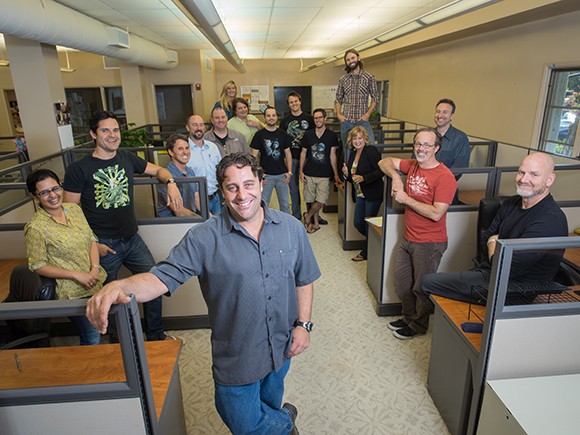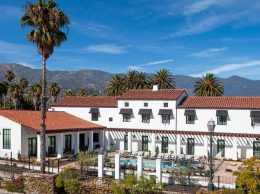HG Data signs up for space in Funk Zone
IN THIS ARTICLE
- Real Estate Topic
- Elijah Brumback Author
By Elijah Brumback Thursday, August 28th, 2014

Employees of Santa Barbara-based HG Data, including CEO Craig Harris, front. The company is moving from its downtown offices, pictured here, to an industrial area of the city, citing lower costs as the reason for the change. (Business Times file photo)
HG Data, a business intelligence firm, recently signed a 3.5-year lease for 9,000 square feet in a former dance studio at 1 N. Calle Cesar Chavez on Santa Barbara’s east side.
The deal is yet another sign that young and growing tech companies favor Santa Barbara over cheaper, more easily-equipped spaces in Goleta or Carpinteria — even if the location is slightly off the beaten path.
While the company is pinching some pennies in the long term with its move from 15 W. Figeuroa St. to the outskirts of the Funk Zone, HG is pouring six-figures into the renovation of its new facility, which it shares with the Synergy Tech Incubator. A move-in date between November and December is expected, said company CEO Craig Harris.
“Our initial thought about moving from the heart of downtown to the industrial zone was a bit concerning, being that we were going from beautiful downtown curb appeal to a location that was centrally located between the Rescue Mission and Cacique Street Homeless Shelter and the Labor Line and the Marborg Porta Potty Storage Yard and the cement factory,” Harris said. “Not quite the curb appeal [and] neighborhood we were dreaming of. However, we were attracted to the affordability, large open spaces with high ceilings and natural light, the ability to be able to pick up adjacent square footage in the Vercal building over time as our company grows and the proximity to the beach, one block away.”
In addition, the proximity to the Funk Zone and roughly 50 restaurants within a five-minute bike ride were also selling points, he said. Other area neighbors include photography and event space 240 Studio, Whitcraft Winery and cloud computing firm RightScale.
“We signed a 3.5-year lease as we plan to really entrench ourselves and stay awhile,” Harris told the Business Times in an email. “We also really like the fact that we are next door to the Synergy Tech Incubator. When we saw the renovations that [architect] Michael Holliday made to the Synergy Tech Incubator, we realized how much potential the location had.”
Holliday, who owns the Synergy Tech Incubator, is also an architect with the firm DMHA and HG has retained his services to do the company’s build out. HG is set to hire a contractor and getting ready to pull permits.
HG also plans to have a fleet of bicycles, which employees can use to go out for lunch, or take a ride on the Cabrillo Boulevard bike path, several stand-up paddle boards and kayaks for employees to use before work, during lunch and after work. The company plans to provide a corporate gym membership to The Training Room and company-sponsored yoga classes at the Loft, both of which are in the same building as HG. On top of all that, Harris said the new space wouldn’t be fit for a growing startup without a game room with Foosball, ping-pong, pool and various old-school arcade games such as PacMan and Galaga.
A lot of younger tech companies seek space in Santa Barbara near the Funk Zone and walking distance to certain amenities, said Mike Martz, a partner at Hayes Commercial Group who brokered the deal for HG.
“Versus being out in Goleta or Carpinteria where there is probably better suited traditional office space, these companies are making the trade off for a more funkier building,” Martz said. “They have a different kind of work environment that’s much more open and set up for collaborative work spaces. When [HG] started looking they needed a large enough, but there were just very few options so we had to get a little creative.”
The approach and feel of the property is similar to the kinds of spaces that have been experiencing renovations for years in the Bay Area, he said.
“For companies like ours – currently at 40 employees and growing fast, it’s really tough to find large spaces downtown,” Harris said. “We are competing with the likes of [wireless music equipment maker] Sonos and other emerging companies, so we needed to come up alternatives to moving to Goleta or Santa Maria or [Carpinteria] or Ventura. In choosing the industrial zone, we hope to see that neighborhood emerge over the coming years as a hub of startup activity.”












